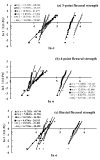Reliability of Different Bending Test Methods for Dental Press Ceramics
- PMID: 33207710
- PMCID: PMC7696483
- DOI: 10.3390/ma13225162
Reliability of Different Bending Test Methods for Dental Press Ceramics
Abstract
Objective: This study investigates the reliability of different flexural tests such as three-point-bending, four-point bending, and biaxial tests, in strengthening the dental pressed ceramics (DPCs) frequently used in clinical applications.
Methods: The correlations between the three types of bending tests for DPCs were investigated. Plate-shaped specimens for the three-point and four-point bending tests and a disc-shaped specimen for the biaxial bending test were prepared. Each bending test was conducted using a universal testing machine.
Results: The results for six DPCs showed that the flexural strength in descending order were the three-point flexural strength, biaxial flexural strength, and four-point flexural strength, respectively. Then, a regression analysis showed a strong correlation between each of the three test methods, with the combination of four-point and biaxial flexural strength showing the highest values. The biaxial flexural strength was not significantly different in the Weibull coefficient (m) compared to the other tests, with the narrowest range considering the 95% interval. The biaxial bending test was found to be suitable for materials with small plastic deformation from the yield point to the breaking point, such as DPCs.
Keywords: biaxial flexural test; dental press molded ceramics (DPCs); weibull coefficient.
Conflict of interest statement
The authors declare no conflict of interest.
Figures






Similar articles
-
The effect of core material, veneering porcelain, and fabrication technique on the biaxial flexural strength and weibull analysis of selected dental ceramics.J Prosthodont. 2012 Jul;21(5):353-62. doi: 10.1111/j.1532-849X.2012.00845.x. Epub 2012 Mar 29. J Prosthodont. 2012. PMID: 22462639
-
Effect of test method on flexural strength of recent dental ceramics.Dent Mater J. 2004 Dec;23(4):490-6. doi: 10.4012/dmj.23.490. Dent Mater J. 2004. PMID: 15688709
-
Correlations among bending test methods for dental hard resins.Dent Mater J. 2017 Jul 26;36(4):491-496. doi: 10.4012/dmj.2016-304. Epub 2017 Apr 18. Dent Mater J. 2017. PMID: 28420833
-
Flexural strengths, failure load, and hardness of glass-ceramics for dental applications.J Prosthet Dent. 2022 Sep;128(3):512.e1-512.e9. doi: 10.1016/j.prosdent.2022.05.023. Epub 2022 Aug 19. J Prosthet Dent. 2022. PMID: 35989200
-
Bending Setups for Reliability Investigation of Flexible Electronics.Micromachines (Basel). 2021 Jan 13;12(1):78. doi: 10.3390/mi12010078. Micromachines (Basel). 2021. PMID: 33451151 Free PMC article. Review.
Cited by
-
Increasing dental zirconia micro-retentive aspect through ultra-short pulsed laser microstructuring: study on flexural strength and crystal phase characterization.Clin Oral Investig. 2022 Jan;26(1):939-955. doi: 10.1007/s00784-021-04077-2. Epub 2021 Aug 17. Clin Oral Investig. 2022. PMID: 34402980 Free PMC article.
-
The Effect of Acidic Immersion Media on the Flexural Properties of a High-Performance Fiber-Reinforced CAD/CAM Technopolymer.Polymers (Basel). 2025 Apr 29;17(9):1216. doi: 10.3390/polym17091216. Polymers (Basel). 2025. PMID: 40363000 Free PMC article.
-
Physical/Mechanical and Antibacterial Properties of Orthodontic Adhesives Containing Calcium Phosphate and Nisin.J Funct Biomater. 2021 Dec 10;12(4):73. doi: 10.3390/jfb12040073. J Funct Biomater. 2021. PMID: 34940552 Free PMC article.
-
Effect of Simulated Mastication on Structural Stability of Prosthetic Zirconia Material after Thermocycling Aging.Materials (Basel). 2023 Jan 30;16(3):1171. doi: 10.3390/ma16031171. Materials (Basel). 2023. PMID: 36770181 Free PMC article.
-
Manufacturing and Characterization of Dental Crowns Made of 5-mol% Yttria Stabilized Zirconia by Digital Light Processing.Materials (Basel). 2023 Feb 9;16(4):1447. doi: 10.3390/ma16041447. Materials (Basel). 2023. PMID: 36837076 Free PMC article.
References
-
- Ukon S., Hisama K., Ogata T., Fukaura Y., Katsumata T., Ishikawa H., Yasumoto M., Matsuura T. A Clinical Evaluation of the Strength of Castable Ceramics (OCC) Crown during a 5-year Follow-up. Jpn. Prosthodont. 1997;41:495–501. doi: 10.2186/jjps.41.495. - DOI
-
- Saitou O., Nakamura T., Takashima F., Maruyama T. The Influence of the Color of the Abutment Tooth on the Color of All Ceramic Crowns. Jpn. Prosthodont. 1996;40:276–283. doi: 10.2186/jjps.40.276. - DOI
-
- Aita H., Ueda Y., Yorimoto T., Hikita K., Ohata N., Uchiyama Y. A atudy on creating the tooth crown basic models used in CAD system for crown restorations. Jpn. Prosthodont. 1998;42:832–838. doi: 10.2186/jjps.42.832. - DOI
LinkOut - more resources
Full Text Sources

